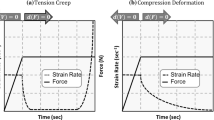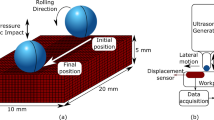Abstract
Background
The rapid determination of the fatigue limit using temperature second harmonic, which is the temperature variation with twice the frequency of the cyclic load, is attractive in terms of time and cost effectiveness. However, the temperature second harmonic contains non-fatigue-related factors (e.g., internal friction and load second harmonic), in addition to fatigue-related factors (e.g., plastic deformation); therefore, this presents challenges in uniquely determining the fatigue limit.
Objective
An experimental procedure for uniquely determining the fatigue limit based on temperature second harmonic measurements is developed.
Methods
In the developed procedure, the temperature second harmonic amplitude is accurately measured using the present phase double frequency (2f) lock-in thermography, and the fatigue limit is then uniquely determined based on the generation mechanism of the temperature second harmonic. The present phase 2f lock-in thermography requires only simple post-processing, considering the phase information of both the non-fatigue-related and fatigue-related factors. The fatigue limit estimation accuracies of the developed procedure and four existing methods are quantitatively evaluated in comparison with the actual fatigue limit for heat-treated carbon steel plate specimens subjected to annealing, normalizing, and quenching–tempering.
Results
By performing simple post-processing, the present phase 2f lock-in thermography easily eliminates the influence of internal friction and load second harmonic. The developed procedure exhibits the second-best estimation accuracies among all the methods for all the heat-treated specimens.
Conclusions
The developed procedure is validated through its reasonable estimation accuracy.





















Similar content being viewed by others
References
Luong MP (1998) Fatigue limit evaluation of metals using an infrared thermographic technique. Mech Mater 28:155–163. https://doi.org/10.1016/S0167-6636(97)00047-1
Bremond P, Potet P (2001) Lock-in thermography: A tool to analyze and locate thermomechanical mechanisms in materials and structures. Proc SPIE (Thermosense XXIII), Orlando, Florida, USA, Mar 2001, pp 560–566. https://doi.org/10.1117/12.421039
Sakagami T, Kubo S, Tamura E, Nishimura T (2005) Identification of plastic-zone based on double frequency lock-in thermographic temperature measurement. Proc the 11th international conference on fracture (ICF 11), Turin, Italy, Mar 2005
Maquin F, Pierron F (2009) Heat dissipation measurements in low stress cyclic loading of metallic materials: From internal friction to micro-plasticity. Mech Mater 41:928–942. https://doi.org/10.1016/j.mechmat.2009.03.003
Ly HA, Inoue H, Irie Y (2011) Numerical simulation on rapid evaluation of fatigue limit through temperature evolution. J Solid Mech Mater Eng 5:459–475. https://doi.org/10.1299/jmmp.5.459
Curà F, Gallinatti AE, Sesana R (2012) Dissipative aspects in thermographic methods. Fatigue Fract Eng Mater Struct 35:1133–1147. https://doi.org/10.1111/j.1460-2695.2012.01701.x
Akai A, Inaba K, Shiozawa D, Sakagami T (2015) Estimation of fatigue crack initiation location based on dissipated energy measurement. J Soc Mater Sci Jpn 64:668–674. https://doi.org/10.2472/jsms.64.668 (in Japanese)
De Finis R, Palumbo D, Ancona F, Galietti U (2015) Fatigue limit evaluation of various martensitic stainless steels with new robust thermographic data analysis. Int J Fatigue 74:88–96. https://doi.org/10.1016/j.ijfatigue.2014.12.010
Palumbo D, De Finis R, Demelio PG, Galietti U (2016) A new rapid thermographic method to assess the fatigue limit in GFRP composites. Compos B Eng 103:60–67. https://doi.org/10.1016/j.compositesb.2016.08.007
Shiozawa D, Inagawa T, Washio T, Sakagami T (2016) Fatigue limit estimation of stainless steels with new dissipated energy data analysis. Procedia Struct Integr 2:2091–2096. https://doi.org/10.1016/j.prostr.2016.06.262
Hayabusa K, Inaba K, Ikeda H, Kishimoto K (2017) Estimation of fatigue limits from temperature data measured by IR thermography. Exp Mech 57:185–194. https://doi.org/10.1007/s11340-016-0221-7
Shiozawa D, Inagawa T, Washio T, Sakagami T (2017) Accuracy improvement in dissipated energy measurement by using phase information. Meas Sci Technol 28:044004. https://doi.org/10.1088/1361-6501/28/4/044004
Kawai R, Yoshikawa T, Kurokawa Y, Irie Y, Inoue H (2017) Rapid evaluation of fatigue limit using infrared thermography: Comparison between two methods for quantifying temperature evolution. Mech Eng J 4:17-00009. https://doi.org/10.1299/mej.17-00009
Shiozawa D, Inagawa T, Washio T, Sakagami T (2017) Effect of mean stress on phase difference of dissipated energy. Proc the 14th international workshop on advanced infrared technology and applications (AITA 2017), Québec, Canada, Sept 2017, pp 183–186
Kawai R, Kurokawa Y, Irie Y, Inoue H (2018) A study on rapid evaluation of fatigue limit based on temperature variation (Source of the second harmonic of temperature variation). Trans JSME 84:17-00462. https://doi.org/10.1299/transjsme.17-00462 (in Japanese)
Ricotta M, Meneghetti G, Atzori B, Risitano G, Risitano A (2019) Comparison of experimental thermal methods for the fatigue limit evaluation of a stainless steel. Metals 9:677. https://doi.org/10.3390/met9060677
Akai A, Shiozawa D, Yamada T, Sakagami T (2020) Energy dissipation measurement in improved spatial resolution under fatigue loading. Exp Mech 60:181–189. https://doi.org/10.1007/s11340-019-00552-w
Akai A, Kojima Y, Murase M, Sato Y, Okubo Y (2021) A study on rapid evaluation of fatigue limit based on dissipated energy measurements (Phase information investigation of dissipated energy). Proc the 70th JSMS annual meetings, May 2021. (in Japanese)
Tokihiro K, Kawai R, Kurokawa Y, Irie Y, Inoue H (2021) A study on rapid evaluation of fatigue limit based on temperature variation (Method for determining the fatigue limit based on the second harmonic amplitude of temperature). Trans JSME 87:21–00177. https://doi.org/10.1299/transjsme.21-00177 (in Japanese)
Pitarresi G, Patterson EA (2003) A review of the general theory of thermoelastic stress analysis. J Strain Analysis Eng Des 38:405–417. https://doi.org/10.1243/03093240360713469
Koe S, Nakamura H, Tsunenari T, Okada T (1983) Relation between bending and direct stress fatigue strengths of steels. J Soc Mater Sci Jpn 32:522–527. https://doi.org/10.2472/jsms.32.522 (in Japanese)
Oliferuk W, Maj M, Zembrzycki K (2015) Determination of the energy storage rate distribution in the area of strain localization using infrared and visible imaging. Exp Mech 55:753–760. https://doi.org/10.1007/s11340-013-9819-1
Acknowledgements
This study was supported by Tsunaji Kitayama, Hiroshi Hohjo (Toyota Central R&D Labs., Inc.), Noriyasu Hayashi, Minoru Hirano, Tohru Onozaki, and Masashi Yoritsune (JTEKT Corporation). The authors express immeasurable gratitude for their support. Additionally, the authors would like to thank Yoshihito Matsufuji, Toshiharu Watanabe, and Takahiro Sakamoto (Shimizutech Co., Ltd.) for their technical assistance with the preparation of heat-treated specimens.
Author information
Authors and Affiliations
Corresponding author
Ethics declarations
Conflicts of Interest
The authors have no competing interests to declare that are relevant to the content of this article.
Additional information
Publisher's Note
Springer Nature remains neutral with regard to jurisdictional claims in published maps and institutional affiliations.
Rights and permissions
Springer Nature or its licensor (e.g. a society or other partner) holds exclusive rights to this article under a publishing agreement with the author(s) or other rightsholder(s); author self-archiving of the accepted manuscript version of this article is solely governed by the terms of such publishing agreement and applicable law.
About this article
Cite this article
Akai, A., Sato, Y., Murase, M. et al. Rapid Determination of Fatigue Limit Using Temperature Second Harmonic. Exp Mech 63, 349–362 (2023). https://doi.org/10.1007/s11340-022-00921-y
Received:
Accepted:
Published:
Issue Date:
DOI: https://doi.org/10.1007/s11340-022-00921-y




